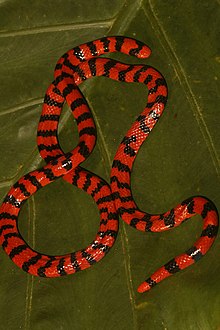Anilius
| Anilius | |
|---|---|

| |
| Scientific classification | |
| Domain: | Eukaryota |
| Kingdom: | Animalia |
| Phylum: | Chordata |
| Class: | Reptilia |
| Order: | Squamata |
| Suborder: | Serpentes |
| Infraorder: | Alethinophidia |
| Clade: | Amerophidia |
| Family: | Aniliidae Stejneger, 1907 |
| Genus: | Anilius Oken, 1816 |
| Species: | A. scytale
|
| Binomial name | |
| Anilius scytale | |

| |
| Synonyms | |
|
List
| |
The Aniliidae are a monotypic family[2] created for the monotypic genus Anilius[3] that contains the single species Anilius scytale.[4] Common names include the American pipe snake and false coral snake.[2] It is found in South America. This snake possesses a vestigial pelvic girdle that is visible as a pair of cloacal spurs. It is ovoviviparous. It is non-venomous, and its diet consists mainly of amphibians and other reptiles. Two subspecies are recognized, including the nominate subspecies described here.[4]
Description
[edit]
This species is found in the Amazon rainforest of South America, the Guianas, and Trinidad and Tobago. It is a moderate-sized snake attaining a size of about 70 cm (28 in) in length. It is fossorial and is rarely seen.[5] It is reported to be ovoviviparous and feeds on beetles, caecilians (burrowing legless amphibians), amphisbaenids or worm lizards (legless lizards), small fossorial snakes, fish (particularly swamp eels), and frogs.[6] It forages for food on the ground, and sometimes in the water, at night.[7] It has a cylindrical body of uniform diameter and a very short tail; it is brightly banded in red and black and its reduced eyes lie beneath large head scales. It is considered to be the snake that most resembles the original and ancestral snake condition, such as a lizard-like skull.[8]
Geographic range
[edit]It is found in the tropics of northern South America from southern and eastern Venezuela, Guyana, Suriname and French Guiana south through the Amazon Basin of Colombia, Ecuador, Peru, and Brazil. The type locality given is "Indiis".[1]
Subspecies
[edit]| Subspecies[4] | Taxon author[4] | Common name | Geographic range |
|---|---|---|---|
| A. s. phelpsorum | Roze, 1958 | ||
| A. s. scytale | (Linnaeus, 1758) |
Taxonomy
[edit]Modern classifications restrict the family to the South American pipe snake or false coral snake (Anilius scytale), with the previously included Asian genus Cylindrophis raised to a separate family, Cylindrophiidae. Anilius is not closely related to Asian pipesnakes. Instead, its closest relatives appear to be the neotropical Tropidophiidae.[9][10]
References
[edit]- ^ a b c d McDiarmid RW, Campbell JA, Touré T. 1999. Snake Species of the World: A Taxonomic and Geographic Reference, Volume 1. Washington, District of Columbia: Herpetologists' League. 511 pp. ISBN 1-893777-00-6 (series). ISBN 1-893777-01-4 (volume).
- ^ a b "Aniliidae". Integrated Taxonomic Information System. Retrieved 14 August 2007.
- ^ "Anilius". Integrated Taxonomic Information System. Retrieved 14 August 2007.
- ^ a b c d "Anilius scytale". Integrated Taxonomic Information System. Retrieved 14 August 2007.
- ^ Lainson, Ralph (April 2005). "The Genus Cyclospora (Apicomplexa: Eimeriidae), with a description of Cyclospora schneideri n.sp. in the snake Anilius scytale scytale (Aniliidae) from Amazonian Brazil: a review". Memórias do Instituto Oswaldo Cruz. 100 (2): 103–110. doi:10.1590/S0074-02762005000200001. hdl:1807/8227. ISSN 0074-0276.
- ^ Niño-Cárdenas, Iván; Aponte-Gutiérrez, Andrés F.; Acosta-Ortiz, Juan (2024). "Pipe Snake (Anilius scytale)". In Arteaga, Alejandro (ed.). Reptiles of Ecuador: Life in the middle of the world. doi:10.47051/INQZ9733 – via reptilesofecuador.com.
- ^ Maschio, Gleomar F.; Prudente, Ana Lúcia da C.; Rodrigues, Francílio da S.; Hoogmoed, Marinus S. (April 2010). "Food habits of Anilius scytale (Serpentes: Aniliidae) in the Brazilian Amazonia". Zoologia (Curitiba). 27 (2): 184–190. doi:10.1590/S1984-46702010000200005. ISSN 1984-4670.
- ^ Evolution – snake
- ^ Pyron, RA; Burbrink, FT; Wiens, JJ (2013). "A phylogeny and revised classification of Squamata, including 4161 species of lizards and snakes". BMC Evolutionary Biology. 13: 93. doi:10.1186/1471-2148-13-93. PMC 3682911. PMID 23627680.
- ^ Reynolds, RG; Niemiller, ML; Revell, LJ (2014). "Toward a Tree-of-Life for the boas and pythons: multilocus species-level phylogeny with unprecedented taxon sampling" (PDF). Molecular Phylogenetics and Evolution. 71: 201–213. doi:10.1016/j.ympev.2013.11.011. PMID 24315866. Archived from the original (PDF) on 2015-12-02. Retrieved 2018-05-14.
Further reading
[edit]- Boos HEA. 2001. The Snakes of Trinidad and Tobago. College Station, Texas: Texas A&M University Press. ISBN 1-58544-116-3.
- Martins M, Oliveira ME. 1999. Natural history of snakes in forests of the Manaus region, Central Amazonia, Brazil. Herpetological Natural History 6: 78-150. PDF Archived 2013-10-09 at the Wayback Machine.
External links
[edit] Data related to Anilius at Wikispecies
Data related to Anilius at Wikispecies Media related to Anilius scytale at Wikimedia Commons
Media related to Anilius scytale at Wikimedia Commons- Aniliidae at the Reptarium.cz Reptile Database. Accessed 3 November 2008.
